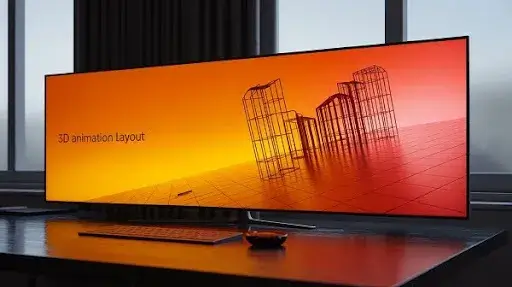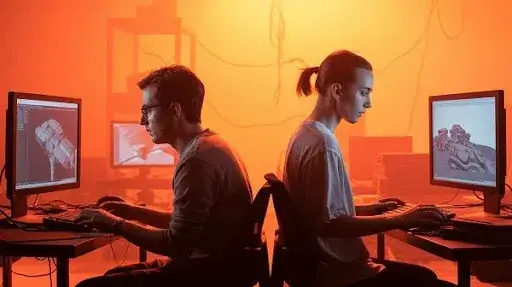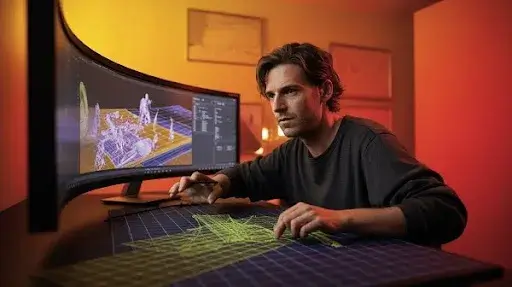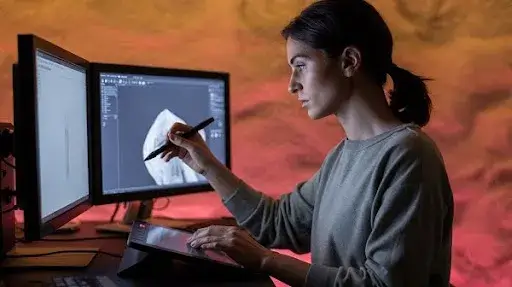There’s a stage in animation that rarely gets the spotlight yet controls nearly everything on screen: the 3D animation layout. If it’s sloppy, the whole film suffers—camera shots feel off, pacing drags, and characters never quite fit their space. If it’s solid, the 3D animation production pipeline runs smoother, and the final piece looks sharp and intentional.
Studios have a saying: “Fix it in layout, or fix it at a much higher cost later.” Layout isn’t just about dropping digital figures into a set. It’s a working plan that guides story beats, camera flow, and even the emotional weight of each moment.
So, what is layout in animation? It’s the phase where artists plot out the action. They decide camera placement, character paths, and scene flow—inside a 3D program, using placeholders and quick drafts. These rough versions become the skeleton that later grows into the polished final render.
The worldwide 3D animation market reached a value of $13.45 billion in 2024, expected to rise to $23.12 billion by 2033, exhibiting a compound annual growth rate (CAGR) of 6.2%. This increase is fueled by growing needs in entertainment, education, and marketing.
This article unpacks why the stage matters, how it fits into the 3D animation pipeline, what layout artists really do, and how strong layouts can make a film look twice as professional.
What Is the Layout in Animation?
Think of layout as the backbone of animated storytelling. Before lighting, textures, or effects come in, the layout decides how a shot looks and plays out.
In traditional 2D animation, this often means sketches showing backgrounds and rough camera angles. With a 3D animation layout, the process digs deeper. Artists use basic models—cubes, spheres, or low-detail stand-ins—to map out scale, positioning, and character motion.
This connects directly with the animatic. The animatic sets timing, but the layout adds space and depth. Together, they let directors preview scenes in a way that feels close to the real thing, long before heavy production work begins.
Why 3D Animation Layout Is Essential
Skipping layout is like building a house without a plan. You’ll get something in the end, but it’s unstable.
Here’s why this stage is vital in the 3D animation production pipeline:
Scale and Perspective
Flat 2D animatics can mislead. Characters might look too close to backgrounds or out of proportion. Layout fixes this by working directly in a 3D environment, so distances and sizes line up correctly from the start.
Creative Freedom for Directors
With layout, directors can play around—switching angles, testing dramatic pans, or shifting staging. It’s far cheaper to make changes here than once detailed animation has begun.
Clear Guidance for Teams
A locked layout becomes the foundation for everyone else. Animators, modelers, lighting crews, and editors all know exactly what they’re building toward. This avoids wasted work and keeps the pipeline steady.
Better Storytelling
Animation isn’t just about motion—it’s about guiding attention. Layout helps shape tension, emotion, and focus in every shot. A strong layout ensures the story comes through cleanly.
Where Layout Fits in the 3D Animation Pipeline
The 3D animation production pipeline generally runs across three phases: pre-production, production, and post-production. The layout stretches through all three.
Pre-Production: Setting the Blueprint
At the start, layout artists take storyboards and animatics, then translate them into 3D setups. They block out cameras, character positions, and movement paths.
Production: Refining the Scenes
As the project moves forward, placeholders are replaced by polished models and animations. Camera paths get finalized. The rough draft slowly sharpens into something cinematic.
Post-Production: Securing Consistency
Even late in the process, layouts remain useful. Editors and compositors rely on them to line up VFX, transitions, and continuity. Without them, post-production would be chaos.
In short: layout isn’t a quick one-off—it grows and evolves with the film until the very end.
Key Elements of 3D Animation Layout
For an example of 3D animation layout to work well, several parts need attention:
- Text and On-Screen Elements
Titles, credits, or graphics must fit without blocking key action. Layout ensures they land naturally.
- Props and Backgrounds
Even as placeholders, their positions must support the story instead of distracting from it.
- Lines and Shapes
Lines guide the eye; shapes build mood. Rounded forms feel calm, while sharp edges create tension.
- Space and Balance
Cramming the frame overwhelms viewers. Layout keeps space open so the main action pops.
- Cinematography and Blocking
Camera angles and staging set the rhythm. Blocking determines how natural or dramatic a scene feels.
- Clarity of Storytelling
Every frame should be easy to follow. If the action feels confusing, the layout needs fixing.
- Acting and Movement
Even with stand-ins, characters get rough poses and motion so animators already have direction later.
Making the Most of 3D Animation Layout
Great layouts don’t happen by accident. Here’s how artists make them work:
- Read and understand the script first. Each shot must serve the bigger picture.
- Keep continuity in mind. Scenes should flow without awkward cuts.
- Use props or backgrounds to communicate details that dialogue doesn’t cover.
- Match the mood. A playful moment calls for gentle framing, while tense shots need sharper angles.
- Treat backgrounds like characters—they shape mood and context.
- Pick camera angles that show perspective or emotion.
- Plan camera movement with enough space to feel natural.
- Layer foreground, mid-ground, and background to add depth.
- Start rough, refine later. Add detail only when the basics work.
- Don’t overload the scene. Clarity beats clutter.
The Role of a 3D Layout Artist
Behind all this is the 3D animation layout artist, often seen as the animator’s version of a cinematographer. Their input affects every frame.
Core responsibilities include:
- Turning storyboards and animatics into usable 3D layouts.
- Building proxy assets to speed up planning.
- Blocking character positions and setting up cameras.
- Refining staging for clarity and emotion.
- Animating rough poses to guide performance.
- Collaborating with directors and other teams.
- Maintaining visual and technical consistency across shots.
Their choices create the foundation for every final render.
Example of 3D Animation Layout in Action
Take a chase scene in a narrow alley. The storyboard might just show two figures running side to side. In layout, artists block in proxy models, add placeholder walls, and plan the camera. The director may decide on an overhead tracking shot to heighten suspense. Later, animators refine the characters, and the lighting teams add shadows.
Without layout, the scene risks feeling flat and unplanned. With layout, every move feels deliberate, and the sequence lands with impact.
Why Studios Build Dedicated Layout Teams
Top studios dedicate entire teams to layout. The reason is simple: it saves money, time, and stress. Catching mistakes at this stage is quick. Catching them after final render is expensive.
Layout also creates a shared vision. Directors, animators, editors, and sound designers all pull from the same blueprint. The clearer the plan, the smoother the project.
Challenges in 3D Animation Layout
Ask any animator where headaches begin, and layout will be near the top of the list. It’s a stage that looks simple from the outside but quickly turns complicated once cameras, timing, and staging come into play. If layout wobbles, the whole 3D animation pipeline feels it. Scenes drag, deadlines slip, and costs creep upward.
The Pressure of Time
Production calendars don’t leave much breathing room. Layout artists are often expected to block a mountain of shots in weeks, sometimes days. That pace doesn’t always allow for experimentation. Do you take the safe angle and stay on schedule, or push for something bold and risk falling behind? The constant trade-off is real.
Communication Snags
Layout connects every major department—storyboarding, modeling, animation, lighting, even editorial. A single vague instruction about a camera move or spacing can ripple into days of rework. Clear notes and fast feedback aren’t nice-to-have, they’re survival tools.
Technical Bottlenecks
Software isn’t magic. Big scene files crawl during playback, hardware limitations make testing camera sweeps a chore, and remote teams often deal with lag and syncing issues. Instead of exploring staging, artists can find themselves fighting laggy tools or bandwidth drops.
Balancing Style and Realism
Not every project aims for realism. Some are designed to be playful, exaggerated, or stylized. Layout artists constantly juggle proportions, perspective, and scale to hit the tone. Push realism too far and it clashes with the design. Lean too heavily into stylization and it breaks immersion. That sweet spot takes practice—and a good feel for storytelling.
In the end, challenges don’t go away completely. Studios that train their teams well and foster open communication tend to sidestep the worst of them.
Tools Used in 3D Animation Layout
Tools don’t replace talent, but the right setup can make life easier. Studios usually mix software depending on the project.
- Autodesk Maya: Still the go-to, especially for flexible cameras and advanced animation controls.
- Blender: Once seen as a hobbyist’s choice, now respected and used in professional productions. Constant updates and the fact it’s free make it attractive.
- Cinema 4D: Handy when motion graphics overlap with 3D animation services.
- Houdini: Known for complex simulations—fire, smoke, fluids, explosions.
- Custom studio tools: Big players like Pixar or DreamWorks often rely on their own in-house systems tuned perfectly to their pipeline.
Alongside the big names, lighter tools—editing apps, storyboard programs—keep departments in sync. The final pick usually depends on budget, project size, and creative goals.
Why Strong Layout Shapes the Final Product
Call layout a “rough sketch” and you’d be selling it short. Viewers can feel a weak layout instantly, even if they can’t put a name to it. Shots drag, the focus is unclear, and the energy dies. When layout works, everything clicks.
- Clarity: The viewer’s eye always lands on what matters.
- Flow: Timing and camera moves keep the story alive.
- Performance: Animators build off layout poses to make characters act convincingly.
- World-Building: Smart staging makes even impossible settings believable.
For studios, strong layout means fewer costly fixes down the road. For audiences, it means the story feels effortless.
The Career of a 3D Layout Artist
A layout artist is half director, half technician. They’re setting shots like a cinematographer, but they’re also inside the software, adjusting frames and camera rigs.
Skills That Matter
- Visual storytelling and timing.
- Mastery of at least one 3D package.
- Strong spatial awareness.
- Teamwork and communication skills.
Breaking Into the Field
Few people start directly in layout. Many cut their teeth in modeling, animation, or storyboarding, then shift toward cameras and staging once they find their interest. Internships and junior roles often provide the first chance to practice on real productions.
Looking Ahead
The demand is only growing, thanks to streaming, gaming, and big-budget animation. Some layout artists move into lead or supervisory roles, others into directing or cinematography. The skillset is flexible and opens doors.
Frequently Asked Questions
Is layout the same as storyboarding?
No. Storyboards sketch ideas in 2D. Layout translates those into 3D shots with cameras, staging, and timing.
Why is layout so important?
Fixing a mistake here is quick. Fixing it after rendering wastes days.
Can Blender really be used in professional work?
Yes. Plenty of studios, large and small, rely on it for layout and previs.
How long does layout take?
It varies. Short films might wrap layout in a few weeks, features can spend months refining it.
Do layout artists animate?
They block poses and timing, but final polish usually belongs to animators.
Final Word
Layout doesn’t grab headlines, but it’s the skeleton of every animated project. It sets pacing, directs the audience’s eye, and builds the foundation for performance. A strong 3D animation layout saves time, avoids costly fixes, and gives animators the structure they need.
For newcomers, the role isn’t about memorizing software. It’s about seeing shots as a storyteller while working with the precision of a technician. For studios, investing in skilled layout artists pays off at every stage of production. And for the audience? They get a smooth, engaging story without ever realizing how much invisible planning held it together.
If you want to hand the difficult tasks of 3D animation production, like 3D animation layout, to professionals, then Prolific Studio is the solution to your problems. Recognized as one of the best animation studios in Boston, we deliver 3D animation projects on time without compromising on innovation and quality.










